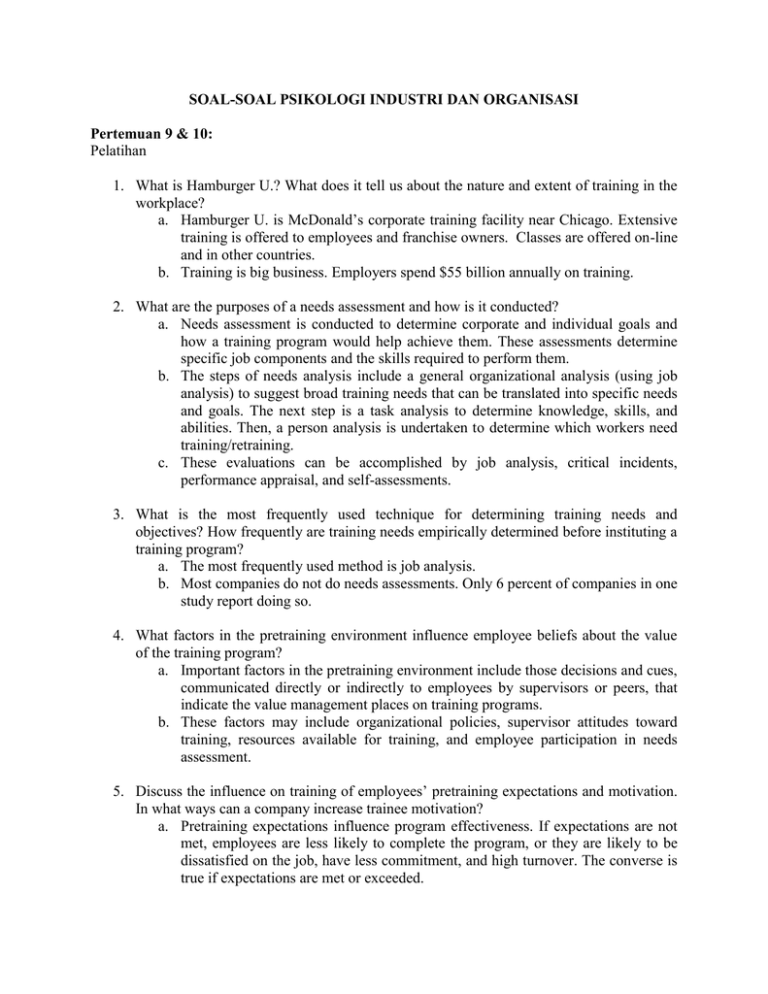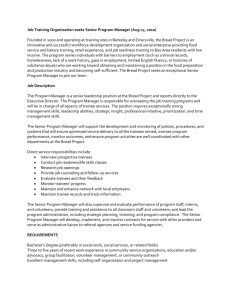SOAL-SOAL PSIKOLOGI INDUSTRI DAN ORGANISASI Pertemuan 9 & 10: Pelatihan
advertisement

SOAL-SOAL PSIKOLOGI INDUSTRI DAN ORGANISASI Pertemuan 9 & 10: Pelatihan 1. What is Hamburger U.? What does it tell us about the nature and extent of training in the workplace? a. Hamburger U. is McDonald’s corporate training facility near Chicago. Extensive training is offered to employees and franchise owners. Classes are offered on-line and in other countries. b. Training is big business. Employers spend $55 billion annually on training. 2. What are the purposes of a needs assessment and how is it conducted? a. Needs assessment is conducted to determine corporate and individual goals and how a training program would help achieve them. These assessments determine specific job components and the skills required to perform them. b. The steps of needs analysis include a general organizational analysis (using job analysis) to suggest broad training needs that can be translated into specific needs and goals. The next step is a task analysis to determine knowledge, skills, and abilities. Then, a person analysis is undertaken to determine which workers need training/retraining. c. These evaluations can be accomplished by job analysis, critical incidents, performance appraisal, and self-assessments. 3. What is the most frequently used technique for determining training needs and objectives? How frequently are training needs empirically determined before instituting a training program? a. The most frequently used method is job analysis. b. Most companies do not do needs assessments. Only 6 percent of companies in one study report doing so. 4. What factors in the pretraining environment influence employee beliefs about the value of the training program? a. Important factors in the pretraining environment include those decisions and cues, communicated directly or indirectly to employees by supervisors or peers, that indicate the value management places on training programs. b. These factors may include organizational policies, supervisor attitudes toward training, resources available for training, and employee participation in needs assessment. 5. Discuss the influence on training of employees’ pretraining expectations and motivation. In what ways can a company increase trainee motivation? a. Pretraining expectations influence program effectiveness. If expectations are not met, employees are less likely to complete the program, or they are likely to be dissatisfied on the job, have less commitment, and high turnover. The converse is true if expectations are met or exceeded. b. Learning will not occur unless trainees want to learn, regardless of ability. Highly motivated workers are likely to complete the program and apply it on the job. c. Trainee motivation can be increased by involving trainees in decisions about the program, allowing participation in needs-assessment, and giving them a choice of training program. 6. How is trainee motivation to perform well in a training program influenced by the factors of locus of control and self-efficacy? a. Individuals with an internal locus of control believe they are in charge of their own destiny. Those with an internal locus of control tend to do better in training. b. Those who believe in their ability to perform a task (self-efficacy) tend to succeed in training. A successful training program can also increase a trainee’s sense of self-efficacy, which can carry over to the job. 7. Describe the effect on learning of active practice, massed versus distributive practice, and whole versus part learning. a. Active practice enhances learning. b. Distributed practice is superior to massed practice. c. Smaller units of material are easier to master. 8. How would you establish a training program to teach people to drive bulldozers? To use computers? a. Following a needs, task, and person analysis the program could be designed. b. The program would be designed with as much active practice as possible. Practice should be distributed with sufficient repetition to allow for each phase of training. Part learning would be beneficial during the training phases, but the final evaluation exam should allow for testing of the whole process. Results of the “test” should be used in further redesign of the program. 9. What factors can hinder positive transfer from a training program to on-the-job experience? a. To enhance transfer of training, the training environment should be similar to the work environment. b. Relevance is important. c. Positive transfer is facilitated by supervisory support, immediate reinforcement, the opportunity to apply new skills, and a follow-up discussion. 10. What reinforcers are used in the workplace? What is their relative importance in improving job performance? a. Typical reinforcers include money (raises and bonuses), social recognition, and positive feedback about job performance. b. In order of importance: money, social recognition, and feedback. 11. Describe the relative merits of vestibule training and on-the-job training. a. On-the-job training takes place directly on the job for which the person has been hired. The major advantage is economy - the organization does not have to establish, equip, and maintain a separate training facility. Transfer of training is usually positive. It may be expensive if it takes other workers away from production. It has the potential for disrupting production. b. Vestibule training takes place in a simulated workplace. The great disadvantage is the cost. If the vestibule program is properly designed, staffed, and equipped, it can be an effective training technique. 12. What are the advantages and disadvantages of computer-assisted instruction as compared to more traditional instructor-led training? a. Trainees learn material at their own pace and receive immediate feedback. It decreases training time required and improves transfer. b. Training can be either centralized or widespread. After the initial startup expense, training costs are reduced by about one-third. c. The downside is that it does not work well with poorly motivated workers, given the self-paced nature of the training. 13. Distinguish between behavior modification and behavior modeling. a. Behavior modification is a training program of positive reinforcement to reward employees for displaying desirable job behaviors. b. Behavior modeling refers to an active demonstration of desired behavior. Trainees attempt to imitate or model their behavior on examples of exceptional performance. 14. How are case studies, business games, and role playing used in management training? a. Case studies are used in executive training in which trainees analyze a business problem and offer solutions. A limitation is that solutions may not be relevant to the job at hand (lack of positive transfer). b. Business games are used to develop problem-solving and decision-making skills. Trainees often compete in teams. Teams deal with corporate problems and instructors evaluate their effectiveness. c. With role playing, trainees pretend to perform a role, displaying the behaviors they believe are appropriate to the situation. It provides an opportunity to practice job-related behaviors. 15. How does executive coaching differ from other management training techniques? In the study of senior managers who received executive coaching, how did their behavior change a year later? a. Executive coaching involves one-on-one training sessions between a coach and a manager to improve the manager’s performance. It is designed to fit individual needs as they arise. b. One year after coaching, trainees were more likely to set specific rather than general goals and to solicit ideas for improvement. The overall performance ratings of those coached was higher than those not coached. c. 16. What factors can influence employee attitudes toward and participation in career development and planning activities? a. Employees are influenced by prior participation in career development activities. b. Those with high self-efficacy led to more positive attitudes and participation. c. Whether or not the organization was supportive made a difference. d. Older workers tended to receive less support. 17. Describe the career stages of working life and the reasons for pursuing career selfmanagement activities. a. Career stages i. Establishment (20-40). People are becoming established in their careers. ii. Maintenance (40-55). Goals and values change. Many seek new challenges and satisfaction. iii. Decline (55 - retirement). Individuals begin to plan for retirement and its loss of work and sense of identity. b. Career self-management refers to the degree a person routinely gathers information and plans for his or her own career. With job loss, down-sizing, and outsourcing, this is a necessity today. 18. What conclusions can you draw about the necessity, value, extent, and worth of employee training programs? a. Studies suggest there is a medium to large positive effect of organizational training. b. There is too often a lack of assessment. c. Some training programs are because some new technique is supported with anecdotal evidence. d. Assessing behavioral changes that following training can be difficult. e. Face validity of management training remains high.

